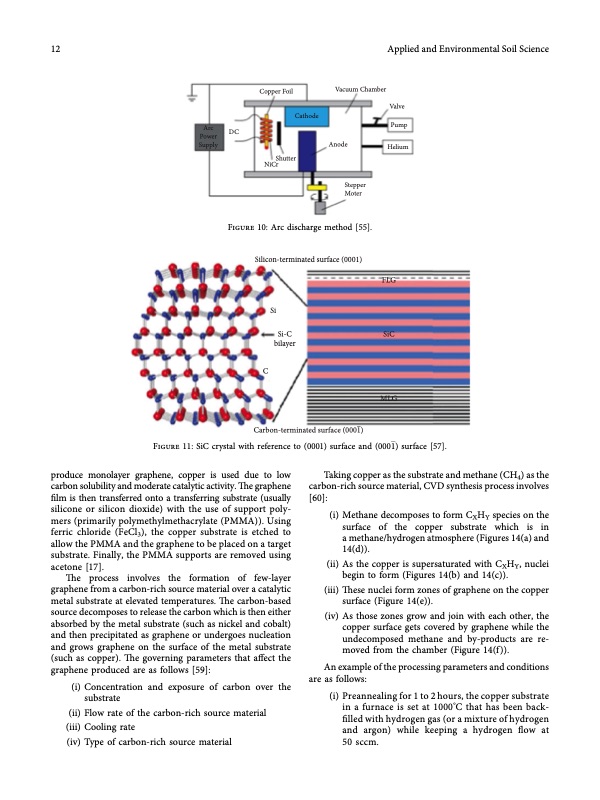
PDF Publication Title:
Text from PDF Page: 012
12 Applied and Environmental Soil Science Arc Power Supply DC Pump Helium Copper Foil Cathode Shutter NiCr Vacuum Chamber Valve Figure 10: Arc discharge method [55]. Silicon-terminated surface (0001) Anode Stepper Moter Si Si-C bilayer C – Carbon-terminated surface (0001) FLG SiC MLG Figure 11: SiC crystal with reference to (0001) surface and (0001) surface [57]. produce monolayer graphene, copper is used due to low carbon solubility and moderate catalytic activity. Te graphene flm is then transferred onto a transferring substrate (usually silicone or silicon dioxide) with the use of support poly- mers (primarily polymethylmethacrylate (PMMA)). Using ferric chloride (FeCl3), the copper substrate is etched to allow the PMMA and the graphene to be placed on a target substrate. Finally, the PMMA supports are removed using acetone [17]. Te process involves the formation of few-layer graphene from a carbon-rich source material over a catalytic metal substrate at elevated temperatures. Te carbon-based source decomposes to release the carbon which is then either absorbed by the metal substrate (such as nickel and cobalt) and then precipitated as graphene or undergoes nucleation and grows graphene on the surface of the metal substrate (such as copper). Te governing parameters that afect the graphene produced are as follows [59]: (i) Concentration and exposure of carbon over the substrate (ii) Flow rate of the carbon-rich source material (iii) Cooling rate (iv) Type of carbon-rich source material Taking copper as the substrate and methane (CH4) as the carbon-rich source material, CVD synthesis process involves [60]: (i) Methane decomposes to form CXHY species on the surface of the copper substrate which is in a methane/hydrogen atmosphere (Figures 14(a) and 14(d)). (ii) As the copper is supersaturated with CXHY, nuclei begin to form (Figures 14(b) and 14(c)). (iii) Tese nuclei form zones of graphene on the copper surface (Figure 14(e)). (iv) As those zones grow and join with each other, the copper surface gets covered by graphene while the undecomposed methane and by-products are re- moved from the chamber (Figure 14(f)). An example of the processing parameters and conditions are as follows: (i) Preannealing for 1 to 2 hours, the copper substrate in a furnace is set at 1000°C that has been back- flled with hydrogen gas (or a mixture of hydrogen and argon) while keeping a hydrogen fow at 50 sccm.PDF Image | State-of-the-Art Graphene Synthesis Methods

PDF Search Title:
State-of-the-Art Graphene Synthesis MethodsOriginal File Name Searched:
8475504.pdfDIY PDF Search: Google It | Yahoo | Bing
Salgenx Redox Flow Battery Technology: Power up your energy storage game with Salgenx Salt Water Battery. With its advanced technology, the flow battery provides reliable, scalable, and sustainable energy storage for utility-scale projects. Upgrade to a Salgenx flow battery today and take control of your energy future.
| CONTACT TEL: 608-238-6001 Email: greg@infinityturbine.com | RSS | AMP |